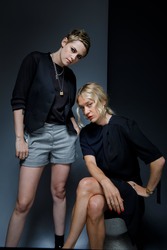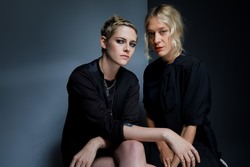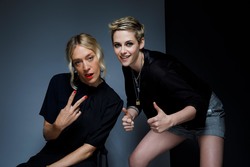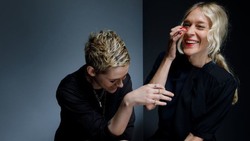Click on portraits for full view.
Over 10 years ago, Chloë Sevigny wasn’t getting the type of movie roles she wanted. Though known for an Academy Award-nominated supporting turn in 1999’s “Boys Don’t Cry,” she was still playing second fiddle. So she created a leading role for herself with “Lizzie,” now playing in limited release, about the infamous Lizzie Borden.
“I wanted to star in a movie,” she said. “I wanted to provide myself the opportunity … and I said I wanted to play this complex character and explore it in depth and come up with our interpretation of the myth of her, the legend of her.”
“Lizzie” is a psychological thriller based on the 1892 killings of Borden’s father (played by Jamey Sheridan) and stepmother (Fiona Shaw). Sevigny plays the titular character in the weeks leading up to the deaths for which she was accused, tried and acquitted. She’s joined by Kristen Stewart, who was on the cusp of stardom in 2008’s “Twilight” when Sevigny was first trying to get this film made and plays the family’s maid and Borden’s lover, Bridget.
Sevigny says she was “very familiar” with the Borden mystery having been born in Massachusetts. She even spent a night at the Lizzie Borden Bed and Breakfast, the home where the murders took place.
“They spin the whole yarn for you and get you spooked out and they say like 50% of the guests leave in the middle of the night,” she said. “Once I heard their pitch I said, ‘This is a movie and I want to make it.’”
The original conception of the project, written by Sevigny’s longtime friend and then-roommate Bryce Kass, landed in the form of a miniseries they shopped at HBO. (Sevigny was near the end of “Big Love” on the network at the time.) As the production stalled, Lifetime released “The Lizzie Borden Chronicles,” a television movie starring Christina Ricci, in January 2014. But Sevigny had already invested so much time and energy that she was still determined to get the film made.
“It took on different forms over the years, but we just decided to make it a smaller film focusing on life in the house and [Lizzie and Bridget’s] relationship,” Sevigny said. “We turned it into a love story.”
And even though Sevigny had had the opportunity to tackle more complex roles since she initially set out to do the film, she “had to see it to fruition.”
“I wasn't going to have it fall by the wayside,” she said. “I had to see it through.”
For Stewart, signing on to the project was simple.
“Just [Sevigny’s] name on the page and the fact that she had put it together herself and the fact that it was her first time producing … and based on my impressions of her from afar and knowing her casually and her work, I knew I would want to be part of it,” she said.
Stewart then read the script and “it proved to be a nice inside look of something I only knew the nursery rhyme version of.”
“I was attracted to the idea of what might lead up to something that heinous and how these two women in similar position [were] bolstering each other and things going wildly out of control.”
While making the movie, the entire team tried not to allow the obsessive interest the case often inspires to impact their work.
“Some of them are fanatical, and I’ve done book adaptations and things that people are passionate about and when it differs from what they believe it [should be], things can get heated,” Sevigny said. “So you have to anticipate that … but hopefully they’ll appreciate what we do and see the beauty and passion in it.”
Stewart added: “For anyone that’s already into this, it would make me happy to know they are interested in something slightly reimagined. And we don’t set ourselves up for criticism because we don’t claim to be spot-on. We present a hypothetical, fully. It’s, ‘Imagine if this happened.’”
Take, for example, the romantic relationship between Sevigny and Stewart’s characters. No one truly knows if the two women were lovers.
“There isn’t too much information on [my character] other than her whereabouts during the murder, which led them to want to have the main element of this story be their relationship. Because the one thing you know for sure is that she must've known that it was going down, because she was the only person there other than Lizzie,” Stewart said. “She was washing windows for two hours? Really?”
Exploring this relationship also allowed the film, Stewart said, to explore what life was like for queer women during a time period in which their narratives are often overlooked.
“There are so many stories that we’ve seen over the years that would have [LGBTQ] story lines that are not present because they just weren’t being acknowledged,” she continued. “Maybe it's a period piece or even an older film where they are not acknowledging the gay element that is probably there. I think it’s really cool to go back and be like, ‘What does gay look like back then?’ and ‘Who would both of these women appear to be? How would they present in a time when they couldn’t be natural with it?’
“I felt super restricted by the clothes alone. You can’t be anything but that black dress, that maid. And when they finally did reveal themselves to each other, even though it was barely fleshed out …”
Sevigny interrupted: “It’s really tender, and practical.”
“And its nice that we didn’t have someone — like our straight male director — step in and say ‘I have ideas about how to tell this story visually,’” Stewart continued. “Nobody was like, ‘Yeah, but let's make it beautiful.’ I love that [when they have sex it’s] kind of run and gun, super real. And it’s not shy and not not trying to show anything. There is an immediacy to it that is authentic and good.”
As such, “Lizzie” is instructive, Stewart said, to “anyone who makes a movie that is not directly reflective of who they are, or something that’s not totally in their wheelhouse.”
Source 1 2 HQ 1 Via 1






No comments:
Post a Comment
What do you think of this?